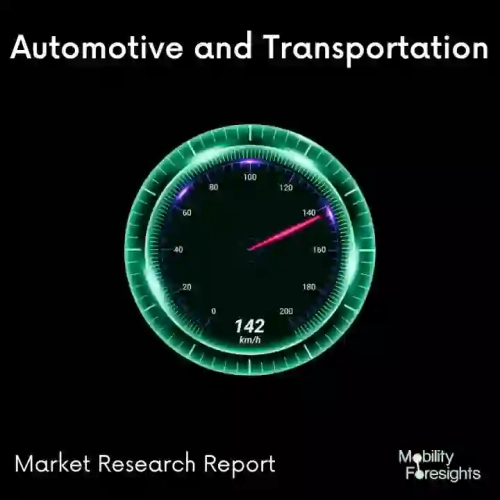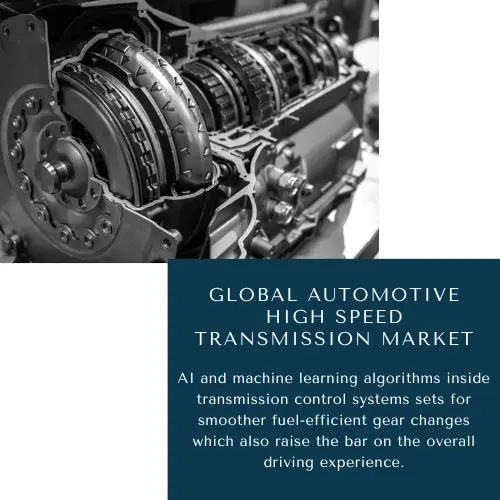
- Get in Touch with Us

Last Updated: Apr 25, 2025 | Study Period: 2024-2030
The global automotive high-speed transmission market is growing, driven by rising demand for high-performance vehicles and a leading trend for electrification in the process within the automotive industry. High-speed transmissions have become more and more important with the popularity of hybrid and electric vehicles, which call for special systems able to achieve optimal performance and efficiency.
These advanced transmissions enhance power management and extend driving range, making electric and hybrid vehicles more attractive to their buyers. Materials lightweight yet strong, such as carbon fiber and new composites, are under test to yield better fuel economy and vehicle performance, thus serving performance enthusiasts better while helping toward sustainability goals.

Advances in technology, especially integration with AI and machine learning algorithms in transmission control systems, serve up a better driving experience by smoother, more fuel-efficient gear changes and real-time adaptation to driving conditions. This improves vehicle responsiveness and safety. The development and manufacturing of such advanced systems come at sizable costs and thereby create problems in terms of pricing and profitability for the market players.
Nevertheless, research and development for innovation and upgrading of transmission technologies in electric and hybrid vehicles present a key opportunity to be exploited by each firm to seek competitive advantage. The market is expected to be dominated by the Asia-Pacific region, considering the large volumes of automotive production and sophisticated consumer demand, especially in countries such as China and India.
Modern automotive high-speed transmissions are key components designed specifically for enhancing performance by keeping an engine running within the ideal revolutions-per-minute range for both power and fuel efficiency. Faster gear changes are supported with these types of sophisticated transmission systems, and increased torque management makes a notable difference in higher acceleration rates and better driving overall.
The advent of hybrid and electric vehicles has driven changes in high-speed transmissions, now featuring technologies like dual-clutch solutions and continuously variable transmissions to meet the demands of modern consumers for both performance and sustainability.
The automotive high-speed transmission market is growing rapidly across the globe, owing to increasing demand for high-performance vehicles and electrification in vehicles during the forecast period, the growth rate is said to be constrained by increasing competition among participants. Coupled with these are innovations in transmission technology, like lightweight materials, advanced control systems, and AI integration, which enhance the efficiency of the vehicle and responsiveness, hence attracting a bigger consumer base.
Other factors that compel manufacturers to develop and implement more efficient transmission solutions are the increasingly strict environmental legislations and rising fuel prices. As the automotive sector evolves, demand for sophisticated high-speed transmissions is forecasted to rise specifically within the Asia-Pacific region, where major automotive manufacturers are concentrated.

The Global automotive high speed transmission market accounted for $XX Billion in 2023 and is anticipated to reach $XX Billion by 2030, registering a CAGR of XX% from 2024 to 2030.
Integration of Artificial Intelligence and Machine Learning: AI and machine learning are integrated more and more into the transmission control systems to bring better accuracy and efficiency while shifting gears. These technologies allow a harmonious change in the sense of the driving conditions in real time in order to bring good fuel economy and better drive experiences. Driven by AI, they study patterns to learn driver behavior, thereby optimizing performance and making a considerable contribution towards vehicle safety and responsiveness.
Advanced Lightweight Materials: With the use of advanced lightweight materials such as carbon fiber, high-strength aluminum alloys, and composites in the transmission components, the weight of the transmission can be reduced. The advanced strength-to-weight ratios found in such materials would facilitate better fuel efficiency with no sacrifice in durability. Lighter transmissions benefit general vehicle lightweighting by providing better acceleration, handling, and energy efficiency that electric and hybrid vehicles strive toward.
Development of Multi-Speed Transmissions for Electric Vehicles: Traditional single-speed transmissions are being replaced with multi speed transmissions for efficiency and improved performance. These allow electric motors to stay within their best efficiency areas during the wide spectra of driving conditions. These innovations lead to extended ranges, better acceleration, and improved energy recovery, and as a result, more competitiveness of electric vehicles with regard to traditional ICE-powered vehicles in terms of performance and practicality.
ZF Friedrichshafen AG's 8-Speed Automatic Transmission :ZF's next-generation 8-speed automatic transmission additively utilizes conventional and hybrid drive systems, attaining better efficiency and lower emissions, and therefore is usable in all vehicles from compact cars to SUVs. Featuring advanced mechatronics and lightweight construction, this latest transmission generation supports higher performance and better fuel economy, thus making ZF one of the companies leading in high-performance transmission technology. This will likely be one of the major drivers for future market growth, where new standards will have to be set with respect to transmission performance and environmental sustainability.
Bosch's CVT4 Hybrid Transmission :Bosch's CVT4 is a continuously variable transmission for hybrid applications that ensures optimal power and efficiency output from e-machines and internal combustion engines. Due to its modular architecture, it provides an easy route to integration into hybrid applications of different types, hence improving driving dynamics and fuel efficiency by smoothly switching over to other power sources. This innovation is expected to make a significant effect on the market in view of a flexible and high-efficiency transmission solution catering to the rising hybrid vehicle demand, increasing Bosch's competitive advantage in hybrid transmission markets.
Magna International's EtelligentReach 2-Speed Transmission :Magna International is focused on providing its EtelligentReach 2-speed transmission for EVs that will unleash enhanced efficiency along with electric drivetrain performance by delivering optimum gear ratios under different driving conditions. This transmission system brings relevant improvements in acceleration and increased driving ranges, including better ways of energy recuperation hence, the major steps forward taken by electric vehicles. With its launch, Magna is likely to impact the market, solving the performance and efficiency-related problems of electric mobility and thus staining a mark in the development of next-generation electric vehicle transmissions.
AUTOMOTIVE HIGH SPEED TRANSMISSION MARKET SEGMENTATION
| Sr.No | Topic |
| 1 | Market Segmentation |
| 2 | Scope of the report |
| 3 | Research Methodology |
| 4 | Executive Summary |
| 5 | Average B2B by price |
| 6 | Introduction |
| 7 | Insights from Industry stakeholders |
| 8 | Key Drivers for automotive high speed transmission Market |
| 9 | Disruptive Innovation in the Industry |
| 10 | Overview of automotive high speed transmission Market |
| 11 | Consumer trends in the industry |
| 12 | Recent technological Trends in automotive high speed transmission Market |
| 13 | SWOT Analysis of Key Market Players |
| 14 | New product development in the past 12 months |
| 15 | Market Size, Dynamics, and Forecast by Geography, 2024-2030 |
| 16 | Market Size, Dynamics, and Forecast by Transmission Type, 2024-2030 |
| 17 | Market Size, Dynamics, and Forecast by Vehicle Type, 2024-2030 |
| 18 | Market Size, Dynamics, and Forecast by Components, 2024-2030 |
| 19 | Competitive landscape |
| 20 | Gross margin and average profitability of suppliers |
| 21 | Merger and Acquisition in the past 12 months |
| 22 | Growth strategy of leading players |
| 23 | Market share of vendors, 2023 |
| 24 | Market Company Profiles |
| 25 | Unmet needs and opportunities for new suppliers |
| 26 | Conclusion |